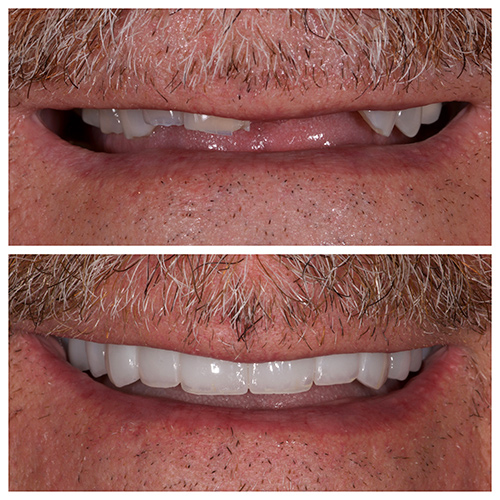Dental Crowns and Bridges in Jupiter

What is a crown?
A crown (or cap) is often indicated when a tooth is damaged due to decay, injury, or deterioration of a large filling. Crowns offer better durability and reliable longevity compared to a large filling and eliminate the potential for teeth developing fractures over time. Also, when ceramic is used, they provide a much more uniform and naturally pleasing appearance.
What to Expect During a Crown Preparation Visit
If the tooth is severely compromised and there is not enough of the natural tooth remaining to support a crown, a procedure called a buildup is performed using composite, to add back enough structure so the tooth can be crowned and preserved. To begin, your doctor will remove the decayed portion of the tooth and apply a special bonding solution that will ensure the composite buildup material adheres to the tooth.

A special curing light is then used to set the bonding fluid. Next, the composite material is applied to fill the prepared area and extend the structure of the tooth. Again, using the curing light, the shaped composite core is solidified into place. Your doctor will shape the core of the tooth into the appropriate design so it can support a crown.
After making the final adjustments, your doctor will take an impression for the crown. At Seaside, we are able to use the iTero® digital scanner for a comfortable, efficient, and accurate substitution to a traditional putty-like impression. The digital impression goes directly to our highly skilled lab to begin the fabrication process. You will leave the practice with a customized temporary crown to cover the prepared tooth and will return after a short period of time to have the final ceramic crown permanently cemented into place.
Composite Fillings vs. Ceramic Crowns
It's important to discuss the differences of both a filling and crown in detail with our doctor at Seaside to determine which treatment option is right for you. Benefits of a filling include the ability to be completed within a single appointment and lessened cost compared to a crown. However, a drawback to a composite filling can be a shorter comparative life span for the restoration and potential long-term issues like recurrent decay and cracking.
The risk of cracking increases as the area to be replaced gets larger. When the tooth cracks, a more extensive procedure will be required to return the tooth to optimal shape and function. Crowns offer better durability and reliable longevity compared to a large filing and eliminate the potential for teeth to develop fractures over time. Also, when ceramic is used, they provide a much more uniform and naturally pleasing appearance.
This procedure is more involved than receiving a filling and can require multiple appointments. While also more of a financial investment than a filling, the durability and reliable longevity offsets this expense over time. In the right circumstances, both a filling and a crown are excellent solutions for repairing decayed or damaged teeth. It is important that you consult with our doctor so that the right choice can be made based upon your unique needs.
A Missing Tooth and the Importance of Replacement
When a tooth is lost, the effects aren't solely limited to the immediate area. There can also be progressive adverse effects to the surrounding and opposing teeth that should be reviewed with our doctor. When a tooth is lost, whether to an injury or decay, the structure of the mouth can begin to alter if the space is left unoccupied.

To start, the immediate area where the tooth is lost suffers adverse changes in the bone and gum support, typically in the form of tissue loss. These changes can spread to the neighboring teeth, resulting in loss of bone support and the teeth drifting into the vacated space. Additionally, the tooth opposing the empty space begins to ascend or descend into the space in a process called over eruption. This then jeopardizes additional surrounding bone structure and teeth. The progression of alterations can lead to issues with a patient's bite as the teeth gradually become misaligned. Each step in this progression can escalate the severity of holistic damage to the mouth as well as the measures needed to remedy it.
A Bridge to Replace Missing Teeth
A bridge uses teeth on either side of the missing tooth for support. It is usually tooth colored and typically made of ceramic. A temporary bridge is placed while your bridge is being expertly constructed by a dental laboratory. At a subsequent appointment, the final bridge is fitted and attached to your teeth. Once completed, the area is restored to optimal function and health. Another common and often superior tooth replacement option is a dental implant.
Our dentist at Seaside is the best resource to help assess your current dental health and recommend the best treatment to fit your unique situation.


